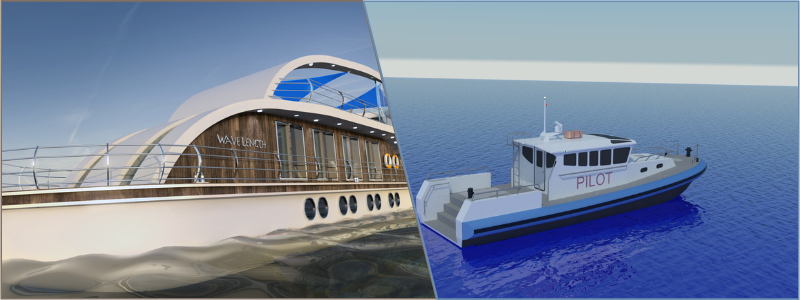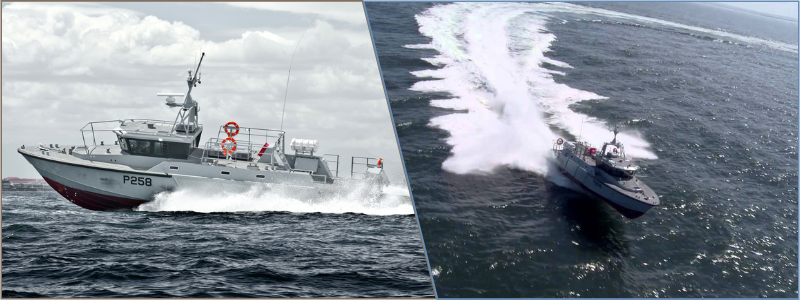This article discusses marine services companies’ average boat design costs and naval engineering rates. Naval architecture design is a highly-specialized mechanical engineering discipline that incorporates shipbuilding and the operation of marine vessels. There are two prominent professions in the field: maritime architect and marine engineer, who work together to design and build water transport vehicles including but not limited to boats, ships, yachts, and submarines. They are responsible for the structure and stability of a vessel and the internal systems such as electrical, propulsion, steering, refrigeration, and, if needed, weaponry.
Table of contents
Boat design cost
Let us start with the average pay rate of naval architects and marine engineers. According to the U.S. Bureau of Labor Statistics (BLS), the median annual wage for either professional was around $93,000 in May 2021. At the bottom end of the spectrum, the median annual wage was $56,500. The highest 10% earned $152,000.
Most naval architects and marine engineers in the top 10% work for the federal government (except postal services) and earn around $105,000 annually. The rest specialized in private water transportation, with an annual salary of $96,000, or scientific and technical assistance for a $95,000 income per year.
Regardless of the industry, the vast majority work forty hours per week (full-time employment) or more at sea because the operational schedules of the ships bind them. Those who work onshore typically have more regular programs than their offshore counterparts. If they provide only boat design services, they do not work at sea but in shipyards or offshore offices.
RELATED: Finite element analysis costs, consulting company rates & engineering services pricing
Estimating plans
Before the plan drawings are ready, it is nearly impossible to have an accurate cost estimation for the design of any particular boat. Without detailed blueprints, any marine vessel is merely an imagination in the owner’s mind. It is an ineffective, if not futile, attempt to calculate the cost of building a boat without sufficient details, ordinarily outlined in the estimating plans document. The first descriptions in the paper include the structure outline, layout, equipment, rig, and general appearance. As always, the idea behind the explanation is to let the contractor and builders know what the owner wants.
Any discussion about cost and direct consultation with a contractor will not likely produce an accurate estimate unless the estimating plans are already in place. Despite your lengthy and elaborate interpretation of the boat, it is almost a certainty that the contractor has a different vision of the vessel. A contractor or anybody else cannot see what you have in mind without a clear illustration. A simple visualization will not be enough either; the tools you need are technical design drawings created by a naval architect. The contractor can only provide the specifics regarding the cost when presented with detailed plans.
RELATED: Use freelance contractors on Cad Crowd as your CAD outsourcing studio

Some clients purchase ready-made boat designs. An accurate estimate is possible if the client does not want to modify the pre-existing plan. The preliminary estimate indicated in the project should be precise enough or at least within a reasonable margin of error. A few hundred dollars difference is arguably tolerable, considering the fluctuation of material prices and contractor fees.
However, it is a sporadic case where a client wants to use an existing design as is. Even simple changes to the appearance, let alone the structural aspect of the boat, can lead to an increase of thousands of dollars depending on the ship’s dimension. The estimate could be misleading if the plan were drawn many years ago without recent updates on specification and cost.
An estimating plan drawn by a naval architect or marine engineer is a detailed sketch of the boat. Although the drawings are often 2D blueprints, the annotations deliver comprehensive information about the boat’s specifications, including appearance, features, and functions. A significant disadvantage of a two-dimensional layout is the lack of realistic visualization.
RELATED: Accessible design: better products for everyone
The contractor knows every component the client needs, but the former may have a different idea for the finish. Another consideration is local resources, both labor and materials. An estimating plan must consider the builder’s skills and shipping cost for the materials, which inevitably affect the project timeline. Local labor cost and efficiency also are parts of the equation.
Avoiding the deviation from the client’s vision is the job of a marine engineer or naval architect, who maintains close communication with the contractor and acts as a liaison between client and contractor. Be that as it may, the professional is not a middle person in a boat design/construction project but a client representative.
Armed with a client-approved estimating plan, they explain to the contractor everything about and related to the 3D model design, for example, specification and timeline. Each time the design changes, the client must be informed for approval. Clients do not typically communicate directly with the contractors and builders. An estimating plan document must include:
| Detailed Sketches/Diagrams | Documents | |
| Structural plan | Template | |
| Exterior profile | Boat specification | |
| Deck plan | List of equipment | |
| Interior profile | Scantlings | |
| Weight (structural and materials) | ||
| Finishes | ||
| Insulation | ||
| Bolting details (for wooden boats) |
Boat specification refers to technical details, such as dimensions, overall appearance, and construction materials for all parts. The engine comes with its specification sheet, which includes the expected power, fuel, and range information. When the estimating plan does not mention a specific engine make and model, the contractor may need approval from the client before purchase. The list of equipment portion of the document must include all electrical and mechanical device designs to be installed in the finished boat.
RELATED: What are the different types of 3D rendering services?
Familiarity is key
The fee for the design alone only makes a small percentage of the total cost. A typical boat design describes the general shape and arrangement of the boat, sail plan, weight, stability calculation, structural strength, scantling specification, propulsion system, and construction method. Detailed construction drawings of those elements may cost between $3,000 and $5,000.
Suppose the contractor or builder is not familiar with the drawings (due to a lack of experience in marine vessel construction). In that case, additional details are necessary to provide an easy-to-understand description. The naval architect or marine engineer will charge an extra fee for the service, and working with an experienced builder will save time and money.
The Case with the percentage of displacement
In boat design, some people still believe that the design fee accounts for around 10% to 15% of the total construction cost. There is also an old rule of thumb to suggest making an estimate based on a “per pound of displacement” basis. Both make little sense because each boat has unique specifications. From the perspective of boat designers, it is easy to make a heavy boat but very difficult to make it light.
Designing and building with “lightweight” in mind takes more time and requires more engineering services. In other words, a lightweight boat’s design and construction cost are more expensive than building a heavy one; the price per pound of displacement also does not apply.
RELATED: Product development guide: how an industrial design company develops your idea

There are similarities between the duties and scope of services of the two professions. Please think of the differences (or relationships) between them as an architect and architectural engineer. The former designs structures, such as houses and factories, while the latter figures out the most effective construction method to achieve the design. Some say an architect prioritizes design creativity, but the job requires more than just creative thinking.
An architect must also understand and be familiar with construction work, materials, environmental concerns, budgeting, and engineering constraints. Given detailed design drawings and specifications by an architect, an engineer uses their extensive knowledge to transform the design into reality. The inside includes mechanical, structural rigidity, propulsion, electrical installation, and construction methods.
RELATED: Top 9 design engineering tips for reducing manufacturing costs on new product designs & prototypes
Marine Engineers
- Prepare boat schematic and detailed drawings
- Define the contract clauses and work schedules
- Conduct a thorough inspection of the equipment to be installed on the boat
- Specify job descriptions for contractors and builders
- Perform supervisory roles during the installation and maintenance of boat equipment
- Conduct performance, operation, and environmental tests on the finished boat
- Communicate with regulatory bodies to make sure safe construction and operation
- Submit technical reports
- Prepare design proposals
- Study the boat specifications and establish the general outline of the boat, including dimensions and power
- Calculate the boat’s stability, the center of gravity, and buoyancy data to determine the most efficient form factor
- Create a complete design of the boat’s exterior and interior, including compartments for engines, passengers, cargo, ladders, and electrical equipment
- Make sure the design process and the finished design comply with regulatory standards.
- Collaborate with the marine engineer to specify the mechanical and electrical designs of the boat, for example, boiler room, refrigeration, propulsion system, steering mechanism, heating, ventilation, and electrical wiring
- Oversee construction
- Deliver thorough evaluation of boat performance
Both professionals must apply knowledge from various engineering fields to design and build boats based on clients’ preferences. Sometimes they have to make design changes to ensure safe operation and that the overall construction does not exceed the predetermined budget.
How can Cad Crowd Assist
Whether you work for a naval architecture firm, own a maritime logistics company, or are an individual looking to create a mega yacht for family travels, our team can work with you to ensure you get the naval design help you need. Visit our website to see the complete list of services we offer. Contact us today for a free quote.
